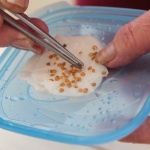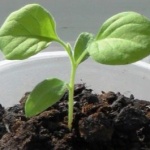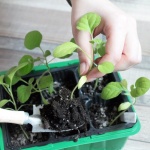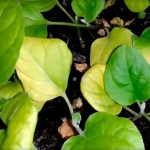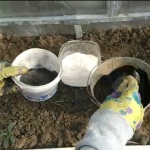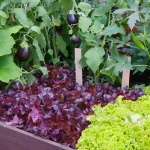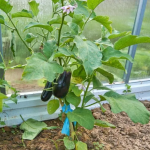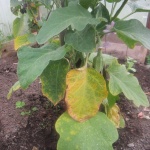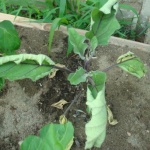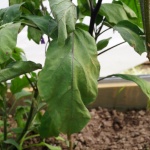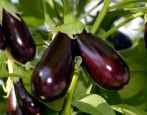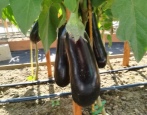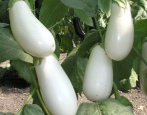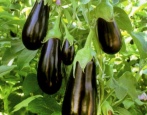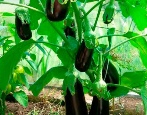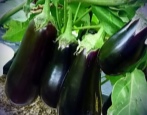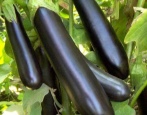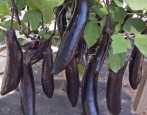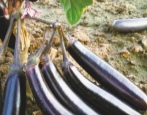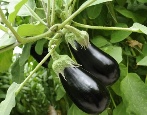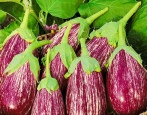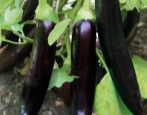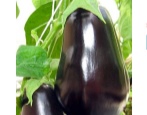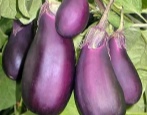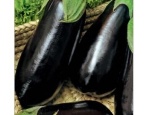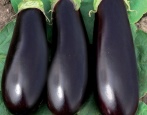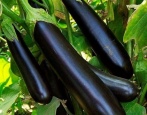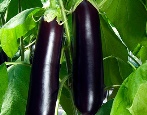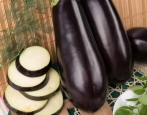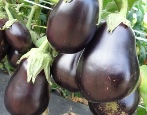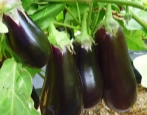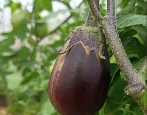
- Name synonyms: Valentina
- Year of approval: 2007
- Growth type: medium-sized
- Bush height, cm: up to 100
- Fruit shape: pear-shaped
- Fruit weight, g: 200-220
- Yield: high yielding
- Fruit color: dark purple
- Keeping quality: excellent
- Marketability: excellent
The Valentina eggplant hybrid is not one of the largest-fruited varieties of this plant, but it is appreciated for its excellent taste, suitability for processing and canning. It is well adapted to the Russian climatic conditions, it has complex immunity against major diseases.
Breeding history
The hybrid passed variety trials in 2007. It was bred by breeders from the Netherlands. Monsanto Holland B.V. filed an application for registration in Russia.
Description of the variety
A versatile hybrid, suitable for growing in open ground, under film shelters and in greenhouses. The marketability and transportability of this eggplant is excellent. The hybrid blooms with large, dark purple buds, pollinates independently, but with the presence of bees on the site, the yield increases noticeably. The root system of the plant is superficial, so it needs additional nutrition during the period of active growth and fruiting.
Characteristics of the appearance of plants and fruits
The bushes are medium-sized, up to 100 cm high, semi-spreading. Stems are strong, pubescent, with a weak or medium-bright anthocyanin coloration. The leaves are not too large, with notches along the edges, a rich green hue.
The fruits are pear-shaped, up to 26 cm long, 5-6 cm in diameter. The average weight of an eggplant is 200-220 g. The skin is dark purple, has a characteristic glossy shine, is easily peeled during processing. The flesh of the fruit is of a dense consistency, with a small amount of seeds, a pale, almost white shade.
Purpose and taste
Fruits for universal use. The taste is assessed as excellent, without the presence of bitterness. The fruits can be kept fresh for up to 3 months. They are used in canning and processing, in the preparation of stews and other dishes.
Ripening terms
Valentina is an early hybrid that ripens in 105-110 days from the moment of germination.
Yield
Valentine is a high-yielding eggplant. Average fees reach 3.2 kg / sq. m.
Growing regions
The hybrid is zoned for most regions of the Russian Federation. It is successfully cultivated in the Far East and Siberia, in the North-West, in the central regions and in the Black Earth Region.
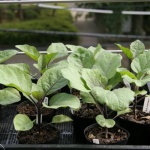
To get a tasty and bountiful eggplant crop, you must first grow strong and healthy seedlings. This culture is considered very capricious, therefore, you need to take care of seedlings when growing at home as correctly and carefully as possible.
Landing scheme
Plants are placed in a garden bed or in a greenhouse according to a 40 × 60 cm scheme.
Growing and care
Sowing seedlings for this eggplant begins in February. Young plants will be ready for transplanting in May. For accelerated germination, the seeds can be treated with a growth stimulant, or soaked in aloe juice for 12 hours. The root system of the plant is sensitive to transplantation, therefore, in the southern regions, direct sowing of this eggplant is practiced, and when grown by seedlings, it is immediately placed in separate containers without picking.
Plant care in the garden is minimal. Valentine's eggplant belongs to moisture-loving hybrids that need regular watering at least 2-4 times a week. About 1 liter of warm settled water is brought under the bush, trying to avoid its contact with the leaves. After that, the earth is necessarily loosened without affecting the roots.To keep the soil moist, it is recommended to mulch the space between plantings.
Top dressing should be regular. The first fertilizers are applied 21 days after planting in a permanent place. A solution of "Kemir" or its analogs is used, with the introduction of the prepared top dressing at the root. Then, every 3 weeks before flowering, the plants are fertilized with organic matter and mineral complexes, alternating between them. At the stage of ovary formation, additional fertilizing from superphosphate and potassium salt, dissolved in water, is introduced.
At the stage of fruit ripening, in July, the bushes are examined, leaving the largest ovaries. The rest are removed, as well as barren flowers. This will allow the plant to direct forces towards a set of eggplant mass and length. In greenhouses, ventilation is required to regulate the temperature. The intense heat affects the size of the fruits, they turn out to be small. It is desirable to maintain the moisture index at a level of up to 70% so that pollination occurs evenly.
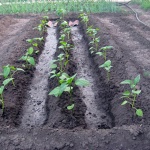
Planting eggplant is one of the most important stages in growing. When choosing a place for eggplants on your site, it is important to remember that this culture should be in warm soil, constantly illuminated by the sun. The plant is also very fond of spacious, open spaces, since its roots can grow over sufficient areas.
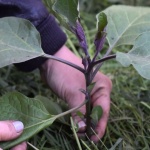
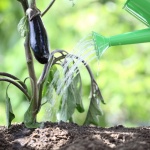
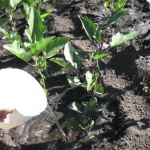
Soil requirements
The best soil for Valentine's eggplant is light, nutritious, loose. It is better to dilute ordinary garden soil with a mixture of peat and sawdust, add urea and wood ash to it. Dense clayey soils are diluted with sand.
Required climatic conditions
This eggplant does not tolerate prolonged periods of bad weather, freezing. With a short-term deterioration of climatic conditions, it preserves flowers without dropping them, continues to set fruit. Grows best in warm temperate climates with predictable warm days. For planting, sunny areas are preferable.
Disease and pest resistance
Plants are resistant to TMV and most other major crop diseases. But at high humidity, they can be affected by fungal diseases. In order to prevent gray rot, the bush should be sprayed with the "Horus" preparation, "Fitosporin" will protect the plant from a complex of pathogenic microorganisms, "Quadris" and its analogues from phytophthora.
Among pests, Colorado beetles and slugs, which damage the leaves, are a particular danger for this eggplant hybrid. They are harvested by hand; for prophylaxis, dusting of bushes and soil with wood ash is used. Noticing on the plants signs of the appearance of aphids or spider mites, it is necessary to treat the planting with insecticides.

Eggplant is one of the most demanding crops.For its successful cultivation, it is necessary to create optimal conditions, as well as to carry out prevention and fight against diseases and pests. Eggplant often infects both fungal and viral diseases. If treatment is not started on time, you can completely lose the crop.
Review overview
Among the obvious advantages of Valentine's eggplant, according to summer residents, is the early maturity and good yield of the plant. Bushes develop well at the seedling stage and after transfer to a permanent place, in a greenhouse, open ground. Seed germination of the hybrid is assessed as high, more than 90% of the sprouts hatch.
Other advantages include the taste of the fruit. They do not taste bitter, they are able to decorate with themselves ratatouille, caviar or other blanks. For baking and frying, tender pulp is also good. As vegetable growers note, during transportation, the dense peel successfully protects the fruits from damage.
Of the shortcomings of Valentine's eggplants, summer residents note the need for timely collection of fruits. Overripe eggplants grow dull, they form well-felt hard seeds inside them, which spoil the taste. And also not everyone is happy with the fact that the plant is a hybrid, which means that seeds have to be bought again every year. It is impossible to get them on your own.
